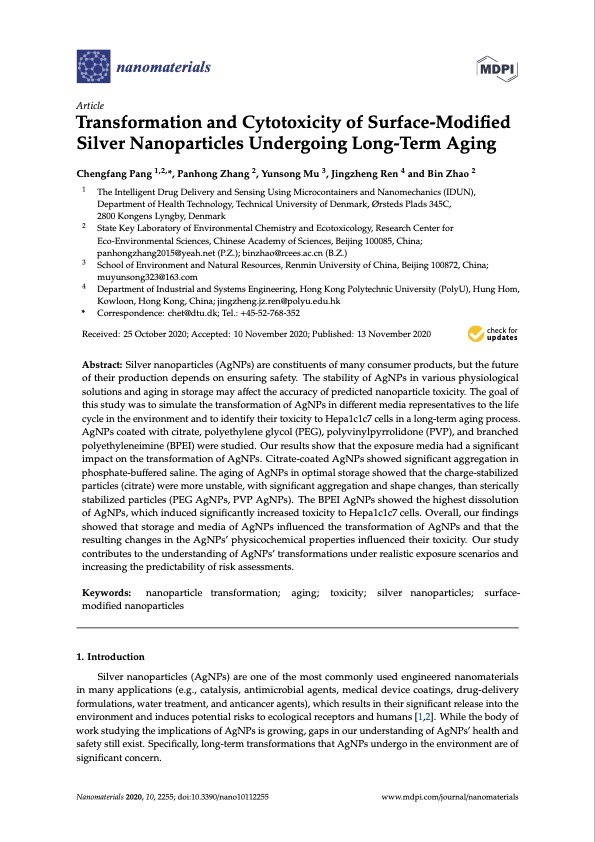
PDF Publication Title:
Text from PDF Page: 001
nanomaterials Article Transformation and Cytotoxicity of Surface-Modified Silver Nanoparticles Undergoing Long-Term Aging Chengfang Pang 1,2,*, Panhong Zhang 2, Yunsong Mu 3, Jingzheng Ren 4 and Bin Zhao 2 1 2 3 4 * Correspondence: chet@dtu.dk; Tel.: +45-52-768-352 Received: 25 October 2020; Accepted: 10 November 2020; Published: 13 November 2020 The Intelligent Drug Delivery and Sensing Using Microcontainers and Nanomechanics (IDUN), Department of Health Technology, Technical University of Denmark, Ørsteds Plads 345C, 2800 Kongens Lyngby, Denmark State Key Laboratory of Environmental Chemistry and Ecotoxicology, Research Center for Eco-Environmental Sciences, Chinese Academy of Sciences, Beijing 100085, China; panhongzhang2015@yeah.net (P.Z.); binzhao@rcees.ac.cn (B.Z.) School of Environment and Natural Resources, Renmin University of China, Beijing 100872, China; muyunsong323@163.com Department of Industrial and Systems Engineering, Hong Kong Polytechnic University (PolyU), Hung Hom, Kowloon, Hong Kong, China; jingzheng.jz.ren@polyu.edu.hk Abstract: Silver nanoparticles (AgNPs) are constituents of many consumer products, but the future of their production depends on ensuring safety. The stability of AgNPs in various physiological solutions and aging in storage may affect the accuracy of predicted nanoparticle toxicity. The goal of this study was to simulate the transformation of AgNPs in different media representatives to the life cycle in the environment and to identify their toxicity to Hepa1c1c7 cells in a long-term aging process. AgNPs coated with citrate, polyethylene glycol (PEG), polyvinylpyrrolidone (PVP), and branched polyethyleneimine (BPEI) were studied. Our results show that the exposure media had a significant impact on the transformation of AgNPs. Citrate-coated AgNPs showed significant aggregation in phosphate-buffered saline. The aging of AgNPs in optimal storage showed that the charge-stabilized particles (citrate) were more unstable, with significant aggregation and shape changes, than sterically stabilized particles (PEG AgNPs, PVP AgNPs). The BPEI AgNPs showed the highest dissolution of AgNPs, which induced significantly increased toxicity to Hepa1c1c7 cells. Overall, our findings showed that storage and media of AgNPs influenced the transformation of AgNPs and that the resulting changes in the AgNPs’ physicochemical properties influenced their toxicity. Our study contributes to the understanding of AgNPs’ transformations under realistic exposure scenarios and increasing the predictability of risk assessments. Keywords: nanoparticle transformation; aging; toxicity; silver nanoparticles; surface- modified nanoparticles 1. Introduction Silver nanoparticles (AgNPs) are one of the most commonly used engineered nanomaterials in many applications (e.g., catalysis, antimicrobial agents, medical device coatings, drug-delivery formulations, water treatment, and anticancer agents), which results in their significant release into the environment and induces potential risks to ecological receptors and humans [1,2]. While the body of work studying the implications of AgNPs is growing, gaps in our understanding of AgNPs’ health and safety still exist. Specifically, long-term transformations that AgNPs undergo in the environment are of significant concern. Nanomaterials 2020, 10, 2255; doi:10.3390/nano10112255 www.mdpi.com/journal/nanomaterialsPDF Image | Silver Nanoparticles Undergoing Long-Term Aging

PDF Search Title:
Silver Nanoparticles Undergoing Long-Term AgingOriginal File Name Searched:
nanomaterials-10-02255-v3.pdfDIY PDF Search: Google It | Yahoo | Bing
Turbine and System Plans CAD CAM: Special for this month, any plans are $10,000 for complete Cad/Cam blueprints. License is for one build. Try before you buy a production license. More Info
Waste Heat Power Technology: Organic Rankine Cycle uses waste heat to make electricity, shaft horsepower and cooling. More Info
All Turbine and System Products: Infinity Turbine ORD systems, turbine generator sets, build plans and more to use your waste heat from 30C to 100C. More Info
CO2 Phase Change Demonstrator: CO2 goes supercritical at 30 C. This is a experimental platform which you can use to demonstrate phase change with low heat. Includes integration area for small CO2 turbine, static generator, and more. This can also be used for a GTL Gas to Liquids experimental platform. More Info
Introducing the Infinity Turbine Products Infinity Turbine develops and builds systems for making power from waste heat. It also is working on innovative strategies for storing, making, and deploying energy. More Info
Need Strategy? Use our Consulting and analyst services Infinity Turbine LLC is pleased to announce its consulting and analyst services. We have worked in the renewable energy industry as a researcher, developing sales and markets, along with may inventions and innovations. More Info
Made in USA with Global Energy Millennial Web Engine These pages were made with the Global Energy Web PDF Engine using Filemaker (Claris) software.
Infinity Turbine Developing Spinning Disc Reactor SDR or Spinning Disc Reactors reduce processing time for liquid production of Silver Nanoparticles.
| CONTACT TEL: 608-238-6001 Email: greg@infinityturbine.com | RSS | AMP |